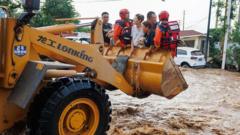At least 30 individuals have lost their lives in Beijing due to severe flooding, with over 80,000 people being evacuated to safety, according to Chinese officials. Alongside this devastation, eight more fatalities were reported from a landslide in Chengde city, located about three hours northeast of the capital. The country is grappling with an unprecedented summer of extreme weather, having faced record heatwaves earlier this month alongside significant flooding in southwestern regions.
In light of the dire situation, President Xi Jinping has emphasized the urgent need for "all-out" rescue endeavors, urging authorities to brace for "worst-case and extreme scenarios." His directives include a comprehensive search for missing persons, the safe relocation of residents from affected areas, and minimizing further casualties.
To assist with recovery, the government has earmarked 200 million yuan (approximately $28 million) for repairing infrastructure and restoring services. The worst hit areas include the outskirts of Beijing, particularly the districts of Miyun and Huairou, where torrential rainfall has inundated numerous roads and left over 130 villages without power. Videos circulating online depict rescue teams navigating through floodwaters to save trapped residents, with helicopters and drones delivering essential supplies to the hard-hit regions.
Concerns are mounting among families with loved ones in severely impacted areas, such as Ms. Yang from Hebei province, who expressed anxiety over her family's wellbeing, having lost contact since the onset of the floods. She fears that her elderly relatives, who have significant health challenges, may not be reached by rescue teams.
Witnesses recount the rapid onset of the flooding, with shop-owner Zhuang Zhelin describing a terrifying experience of watching the floodwaters rise perilously fast. Past flooding events, like the catastrophic deluge of July 2012, which claimed 79 lives, remind residents of Beijing's susceptibility to such weather extremes.
The summer's turmoil continues as flood-related casualties proliferate across China. Earlier this month, Typhoon Wipha wreaked havoc in Shandong province, claiming two lives and leaving ten individuals missing, while other landslides in southwest China resulted in additional fatalities. Increasingly severe weather patterns, often attributed to climate change, pose grave risks to both the residents and the economy of China, particularly affecting its agricultural sector, as reported by the emergency management ministry that estimated disaster-related costs at 54.11 billion yuan (around $7.5 billion) in the first half of the year, with flooding responsible for over 90% of the losses.





















